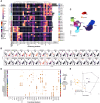Granulysin Antimicrobial Activity Promotes Dormancy in Mycobacterium tuberculosis
- PMID: 40776481
- PMCID: PMC12332329
- DOI: 10.1002/eji.70004
Granulysin Antimicrobial Activity Promotes Dormancy in Mycobacterium tuberculosis
Abstract
Human tuberculosis (TB) caused by Mycobacterium tuberculosis (Mtb) remains a global public health threat. Granulomas constitute a hallmark of TB pathogenesis that can clear, contain, or exacerbate an infection. Containment is exploited by Mtb as a hideout to persist in a dormant, antibiotic-tolerant state, only to resuscitate upon immunosuppression. The immune determinants of a granulomatous response driving Mtb persistence remain elusive. We here generated ex vivo granuloma-like structures from peripheral blood mononuclear cell specimens of TB patients and applied high-dimensional mass cytometry to elucidate immune factors prompting Mtb dormancy. Compared with healthy controls, patient-derived specimens rapidly forced Mtb to become dormant-like ex vivo. This observation correlated with an enrichment in activated, innate (-like) cytotoxic lymphocytes and required the presence of CD56+ lymphocytes or, more specifically, the content of their granules. Finally, we demonstrated that direct exposure to granulysin induces Mtb dormancy, thereby unravelling an immune escape mechanism to cytotoxic lymphocyte activity.
Keywords: CyTOF; Mycobacterium tuberculosis; NK cells; bacterial infections; cellular immunology; cytotoxicity; dormancy; granuloma; granulysin; immune evasion.
© 2025 The Author(s). European Journal of Immunology published by Wiley‐VCH GmbH.
Conflict of interest statement
The authors declare no conflicts of interest.
Figures




References
-
- Global tuberculosis report 2023 . Geneva: World Health Organization; 2023. Licence: CC BY‐NC‐SA 3.0 IGO.
MeSH terms
Substances
Grants and funding
LinkOut - more resources
Full Text Sources
Medical
Research Materials

